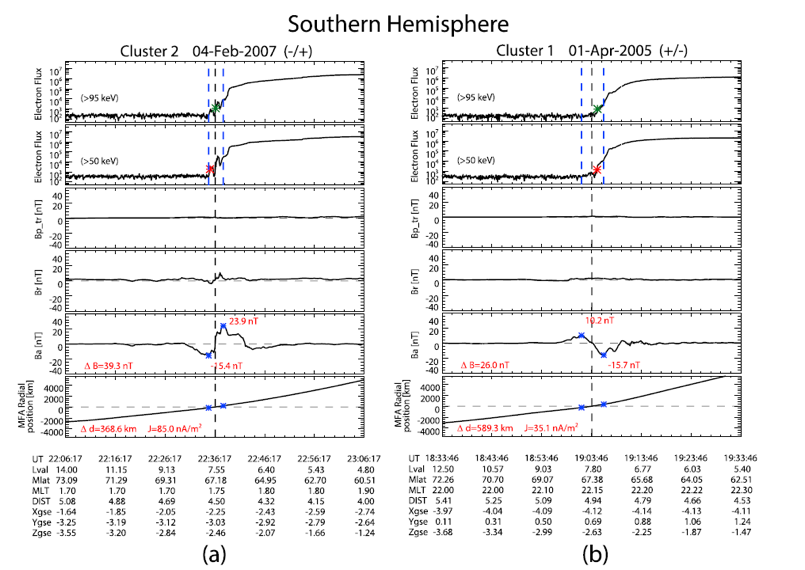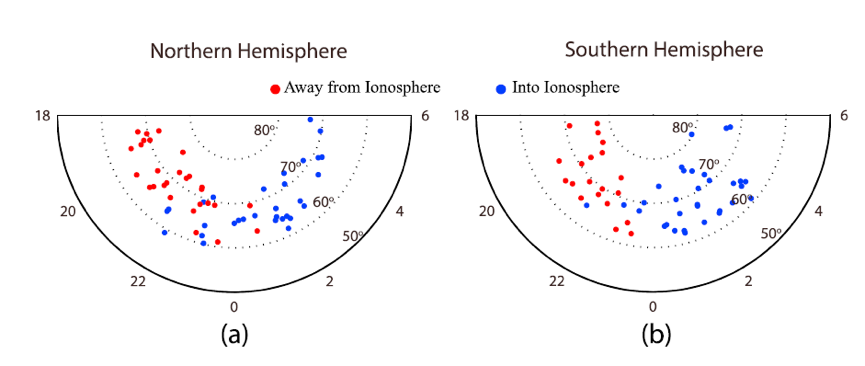场向电流在磁层-电离层耦合中扮演着重要的角色,其产生机制、分布特征、时空演化一直是磁层物理研究的热点和难点。本工作利用Cluster卫星的磁场和能量电子的观测发现在能量电子的边界处磁场有一个双极性特征,并且在局地场向坐标系下磁场的变化主要是在环向,即场向电流。利用Cluster卫星从2001到2008年的观测数据,我们对这些磁场和电子观测做了统计研究。主要结果包括:(1)在一维电流片假设的前提下,计算得到场向电流的大小为几十nA/m2、厚度为几百公里;(2)电流在晨侧流入电离层,在昏侧流出电离层,这跟一区场向电流的性质是一致的;(3)这些电流投影到电离层高度后磁纬度分布在60o-75 o之间。我们还发现这些电流的强度和相应的磁场变化跟Kp指数、太阳风动压有正相关的关系,而跟AE指数几乎没有相关性。
该成果近期发表在Journal of Geophysical Research: Space Physics上,文章链接http://onlinelibrary.wiley.com/doi/10.1002/2015JA021754/full
文章作者为:任杰,宗秋刚,周煦之,张慧,傅绥燕,王永福,刘勇
Ren, Jie, et al. "Statistics of the field‐aligned currents at the high‐latitude energetic electron boundaries in the nightside: Cluster observation." Journal of Geophysical Research: Space Physics (2016) Doi: 10.1002/2015JA021754
Statistics of the field-aligned currents at the high-latitude energetic electron boundaries in the nightside: Cluster observation
Magnetic field disturbances with a clear bipolar signature are frequently observed when the Cluster spacecraft fleet pass through both Southern and Northern high-latitude energetic electron boundaries at the nightside magnetosphere. The dominant variation of the bipolar signature is in the azimuthal direction of the local mean field-aligned coordinate, indicating a field-aligned current. From 2001 to 2008, we have examined 110 events with the magnetic field and energetic electron measurements. The main results can be summarized as: (1) The density and thickness of the field-aligned current, calculated under the assumption of the one-dimensional sheet, are in order of tens of $nA/m^2$ and hundreds of km, respectively. (2) Currents flowing into and away from the ionosphere tend to be observed in the post-midnight and pre-midnight sector, respectively, which have the same polarity as the region 1 current system. (3) These currents mainly distribute in the 60o-75 o magnetic latitude region after mapping to the ionosphere. We also find that the current density and corresponding magnetic field variation are positively correlated with the Kp index and solar wind pressure, but almost independent of the AE index.



